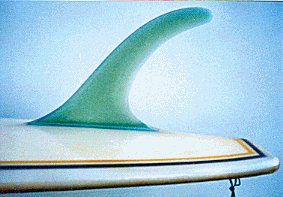
... this is a FIN. Well I am pleased to say that as of this week I can confirm that my HWS design is no Chinese shark as the fin design is finally all but finished... Frontal height from base to tip has been set at 9” with a perpendicular base cord length of around 10”. The actual fin base finished up around the 9.5” mark. The trailing edge has been setup to extend 1” past the tail at a height of 8”, measured from the center line of the rail at the tail and the fin height from the back stands at 10”.

The cord length used to calculate the foil was one inch larger then the designed cord length as explained earlier in the section entitled “
The D Fin”. Due to the thickness (approximately 1.5”) obtained when using a NACA 0012 foil in conjunction with my cord lengths, a NACA 0007 foil was chosen. This was done partly due to a gut feeling but more on the fact that Tom Wegener makes his fins ¾” thick. Hopefully I can get some numbers for such things as the total surface area, volume, etc. at a later date if I ever get around to modeling it in 3D. I am now contemplating whether or not to glass the fin lightly to create a positive buoyant fin which could provide some positive benefits in terms of increased buoyancy, reduced weight, higher flex coefficient, increased angular thrust force, etc. or to go with the original idea of thick glass primarily for use as a counter balance.
Foil design:Three major influences have historically effected the design of foils, Bernoulli´s Principle, Coanda Effect and Newton’s Third Law of motion.
Bernoulli’s Principle basically states that with a high velocity fluid flow, a lower pressure is exerted on a surface parallel to the flow. Wikipedia states
“It is a common misconception that the pressure differential (caused by the Bernoulli principle) is the direct cause of lift”. Therefore it is safe to say that Bernoulli principle provides a means for generating the deflection which inturn generates lift, or alternatively drag. The Coanda Effect states that
“a fluid stream will follow a surface that curves away”. Newton’s Third law helps explain that a downwards deflected fluid flow is balanced by an equal upward force on the foil, hence lift.
For symmetric foils (eg. NACA 00xx) with zero angle of attack the factor for lift is cancelled or equivalent to zero. This is the case in general for a surfboard center fin moving in a straight line; hence foils are a very important factor when designing surfboard fins. In order to calculate the profile of a symmetric NACA 00xx foil the following formula can be used, with "xx" representing the percentage of the thickness of the chord:
y = (t/0.20).[0.29690.(x^1/2) -0.12600.(x) – 0.35160.(x^2) + 0.28430.(x^3) -0.10150.(x^4)]Where :
y = The thickness of the foil at any given value of X
x = Possition along the cord from 0 to 1
t = The maximum thickness as a fraction of the cord
The leading edge of the foil is approximated by a cylinder with a radius (r) of:
r = 1.1019.(t^2)
Alternatively, you may prefer to use the link posted earlier to a site that automatically calculates the the foil with minimal amount of user input.
Useful Links:  ... tomorrows a Mystery and today is a gift that is why its know as the present, a wonderful Chinese proverb… Paulownia, a wonderful Chinese wood. For now the board building is definitely on hold as I have signed a contract to return to DBGI in Wollongong, Australia, starting 01/12/2008. So the wait must go on until a suitable building area is arranged and material sort... thats if I don't redesign the whole thing between now and then. I will be staying with a friend (John) initially until Marta and Miguel head over or a nice place comes up, I just need to get myself a bike and East Corrimal here I come.
... tomorrows a Mystery and today is a gift that is why its know as the present, a wonderful Chinese proverb… Paulownia, a wonderful Chinese wood. For now the board building is definitely on hold as I have signed a contract to return to DBGI in Wollongong, Australia, starting 01/12/2008. So the wait must go on until a suitable building area is arranged and material sort... thats if I don't redesign the whole thing between now and then. I will be staying with a friend (John) initially until Marta and Miguel head over or a nice place comes up, I just need to get myself a bike and East Corrimal here I come.















